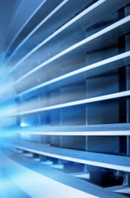|
|
||||||
Heating, Ventilation & Air Conditioning (HVAC) SystemsHeating resides on the opposite side of climate control from air conditioning and refrigeration; both heating and air conditioning systems working together will guarantee the comfort of your home or business in all weather conditions. Heating and cooling systems are often referred to as HVAC, which stands for “Heating, Ventilation, and Air Conditioning.” Home heating systems can be as simple as a space heater, or as complicated as a heat pump system that regulates both your heating and air conditioning units. Heating systems are either classified as central or local. Central heating functions much like central air: water, steam, or air is warmed in a central location, then distributed throughout the building through ductwork, which can be shared by both heating and air conditioning units. Central heating usually involves a device called a furnace, which sucks air into your home’s ductwork. The air is then transported to an area where it is warmed, before being flushed into the atmophere by a radiator in a process known as convection. Heat pumps, which contain both a heater and an air conditioner, are another example of a central heat device. Local heating operates through electricity, usually in the form of a portable space heater or baseboard heaters; like portable air conditioning, portable heating is useful in smaller spaces and is often more economical and easier to maintain. Proper ventilation is crucial to maintaining air quality in a heated environment. Just as air conditioning filters rid the air of contaminants, mechanical exhausts remove unpleasant odors and circulate clean air throughout a bath or kitchen. Electric fans can keep air moving, in addition to the old-fashioned method of cracking a window for fresh air. Devices such as humidifiers will replace the moisture removed from air during the heating process. Home heating systems can be easily equipped with ventilation tools by a heating contractor. Regular maintenance will contribute to an efficient heating, so make sure you change furnace filters regularly. In the case that your heating and ventilation system fails to adequately heat your home or business, first consult your heater’s manual for advice. Also try the following steps:
If the furnace problem persists, then seek the services of a qualified heating repair technician. Uneven heat distribution is sometimes the issue, which often results in the inability to heat some rooms in the house, such as upstairs bedrooms. This can be due to leakage of warm air out through joints in your electric furnace’s heating ducts, or heat loss from ductwork passing through the basement, or loss of heat through colder areas such as a crawl space, an attic, or a garage. Finally, if your home uses a gas furnace
and you detect the odor of gas, leave immediately.
Such a smell indicates the presence of a gas leak, and should
be treated as an emergency. Contact your local utility company
once you have vacated the building. |
| FAQs Resources Sitemap Contact Us Directory All Rights Reserved © Copyright 2007 Air-Conditioning-Filters.com |



